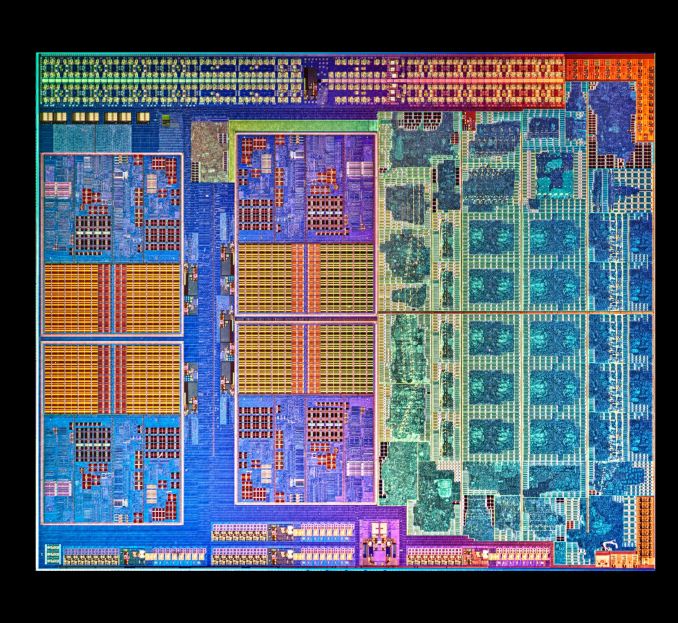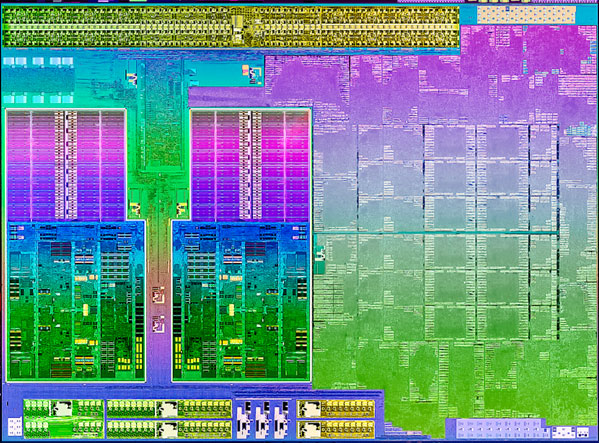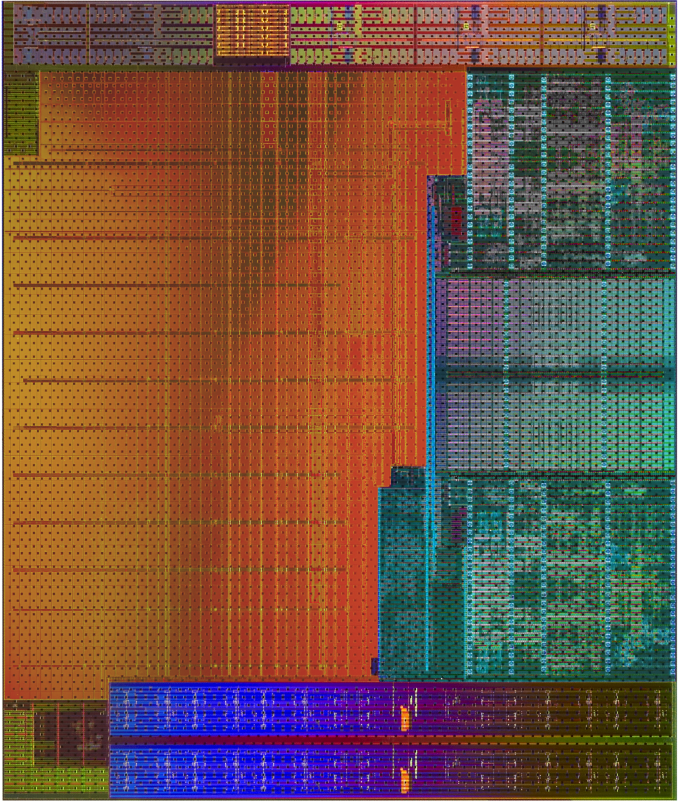AMD Kaveri Review: A8-7600 and A10-7850K Tested
by Ian Cutress & Rahul Garg on January 14, 2014 8:00 AM ESTLlano, Trinity and Kaveri Die: Compared
AMD sent along a high res shot of Kaveri's die. Armed with the same from the previous two generations, we can get a decent idea of the progression of AMD's APUs:
Llano, K10 Quad Core
Trinity and Richland Die, with two Piledriver modules and processor graphics
Kaveri, two modules and processor graphics
Moving from Llano to Trinity, we have the reduction from a fully-fledged quad core system to the dual module layout AMD is keeping with its APU range. Moving from Richland to Kaveri is actually a bigger step than one might imagine:
| AMD APU Details | ||||
| Core Name | Llano | Trinity | Richland | Kaveri |
| Microarch | K10 | Piledriver | Piledriver | Steamroller |
| CPU Example | A8-3850 | A10-5800K | A10-6800K | A10-7850K |
| Threads | 4 | 4 | 4 | 4 |
| Cores | 4 | 2 | 2 | 2 |
| GPU | HD 6550 | HD 7660D | HD 8670D | R7 |
| GPU Arch | VLIW5 | VLIW4 | VLIW4 | GCN 1.1 |
| GPU Cores | 400 | 384 | 384 | 512 |
| Die size / mm2 | 228 | 246 | 246 | 245 |
| Transistors | 1.178 B | 1.303 B | 1.303 B | 2.41 B |
| Power | 100W | 100W | 100W | 95W |
| CPU MHz | 2900 | 3800 | 4100 | 3700 |
| CPU Turbo | N/A | 4200 | 4400 | 4000 |
| L1 Cache |
256KB C$ 256KB D$ |
128KB C$ 64KB D$ |
128KB C$ 64KB D$ |
192KB C$ 64KB D$ |
| L2 Cache | 4 x 1MB | 2 x 2 MB | 2 x 2 MB | 2 x 2 MB |
| Node | 32nm SOI | 32nm SOI | 32nm SOI | 28nm SHP |
| Memory | DDR-1866 | DDR-1866 | DDR-2133 | DDR-2133 |
Looking back at Llano and Trinity/Richland, it's very clear that AMD's APUs on GF's 32nm SOI process had a real issue with transistor density. The table below attempts to put everything in perspective but keep in mind that, outside of Intel, no one does a good job of documenting how they are counting (estimating) transistors. My only hope is AMD's transistor counting methods are consistent across CPU and GPU, although that alone may be wishful thinking:
| Transistor Density Comparison | ||||||||
| Manufacturing Process | Transistor Count | Die Size | Transistors per mm2 | |||||
| AMD Kaveri | GF 28nm SHP | 2.41B | 245 mm2 | 9.837M | ||||
| AMD Richland | GF 32nm SOI | 1.30B | 246 mm2 | 5.285M | ||||
| AMD Llano | GF 32nm SOI | 1.178B | 228 mm2 | 5.166M | ||||
| AMD Bonaire (R7 260X) | TSMC 28nm | 2.08B | 160 mm2 | 13.000M | ||||
| AMD Pitcairn (R7 270/270X) | TSMC 28nm | 2.80B | 212 mm2 | 13.209M | ||||
| AMD Vishera (FX-8350) | GF 32nm SOI | 1.2B | 315 mm2 | 3.810M | ||||
| Intel Haswell 4C (GT2) | Intel 22nm | 1.40B | 177 mm2 | 7.910M | ||||
| NVIDIA GK106 (GTX 660) | TSMC 28nm | 2.54B | 214 mm2 | 11.869M | ||||
If AMD is indeed counting the same way across APUs/GPUs, the move to Kaveri doesn't look all that extreme but rather a good point in between previous APUs and other AMD GCN GPUs. Compared to standalone CPU architectures from AMD, it's clear that the APUs are far more dense thanks to big portions of their die being occupied by a GPU.













380 Comments
View All Comments
Fox5 - Tuesday, January 14, 2014 - link
Where are the Iris Pro results in CLBenchmark? Where are the CPU results of CLBenchmark; is the GPU faster than Haswell's AVX2? Where's the rest of the compute benchmarks, the area that Kaveri is supposed to shine in?JDG1980 - Tuesday, January 14, 2014 - link
Incidentally, will HTPC be covered in a different review? MadVR could be a good use case for Kaveri, as it requires quite a bit of shader power but isn't that memory bandwidth intensive.beomagi - Tuesday, January 14, 2014 - link
Per charts, Why are 100W APUs slower in 1280x1024 than at higher resolutions??beomagi - Tuesday, January 14, 2014 - link
Also, 45W APUs are faster? Are the benchmarks different? The charts only mention resolution.beomagi - Tuesday, January 14, 2014 - link
Nevermind - I now see this is as a percent difference compared to the slower chip - the title said FPS and that threw me off.Ignore! :D
Dribble - Tuesday, January 14, 2014 - link
Call me cynical but it's just the same as the previous gen. If you want a small form factor extreme budget gaming box these will be pretty good. For the rest of the world if you don't care about games you'd do better going Intel, and if you do intel + a proper graphics card.As with previous gen it comes with a load of marketing slide advantages, which if previous gen are anything to go by will come to nothing - I don't see the current range of AMD machines blowing away intel machines with opencl/stream/fusion/whatever - and that was what was on the previous set of marketing slides.
I always thought their best bet was mobile - but these days that markets getting really tough now for AMD as Intel have just spent the last few years optimising power usage.
UtilityMax - Tuesday, January 14, 2014 - link
The biggest elephant in the room is that very few average people (those who don't visit this web site) care for playing games on laptops (or even desktops, considering the consoles). Once you ignore the gaming performance, the A10 APU effectively has the performance of Core i3, but at a high price. A Fry's or Best Buy "special" laptop with Core i3 can cost as low as $400 or less. But the A10 laptops cost around $500. Intel's pricing is pretty aggressive on the low end IMHO.jimjamjamie - Thursday, January 16, 2014 - link
Not just in laptops, the price/performance ratio of the dual-core Pentiums is extremely good - the Haswell-based Pentium G3220 (3GHz dual core, 3.5MB cache) is available in the UK for just over £40, which is excellent value.Nagorak - Wednesday, January 15, 2014 - link
Yes, the issue is that the hybridization of CPU/GPU really provides no advantages. For someone actually playing games the GPU is still too weak and they'd be better off with a discrete card. For someone not playing games the quality of the integrated GPU doesn't matter.Maybe I'm wrong and there are tons of people out there playing games at ~30 FPS with low settings. I just don't see why someone who wants to play games wouldn't try to cough up an extra $100 for a discrete GPU, and if you don't play games then even Intel's older HD GPUs are fine.
mikato - Wednesday, January 15, 2014 - link
*For someone actually playing [newer 3D intensive] games the GPU is still too weak and they'd be better off with a discrete card. Yep*For someone actually playing [older or lighter] games the GPU is good enough and you end up with a cheaper overall package without needing a discrete card.
*For someone not playing games, they will benefit big time from HSA eventually. Not there yet and depends on the software.
There are probably more people in the last two categories if you think about it. AMD isn't for us gamers right now unfortunately. And it's going to take a while for adoption for HSA to bring in the third category of people.